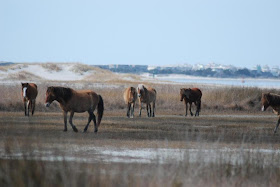 |
| Sketch of Beaufort Harbor - US Coast Survey Office - Ordered 1844, Completed 1851 |
In the early 1900s the U.S. Army Corp of Engineers began dredging the mouth of Taylor's Creek, using Carrot Island and Town Marsh as dredge material deposition areas. Before the dredging, these islands were essentially all tidal marsh with some elevated hammock land.
 A Beaufort resident, Dr. Luther Fulcher, placed horses on the Reserve's islands in 1947.
Livestock was also taken over to the islands to graze. With the
resident's passing, the horses remained and became feral, reverting from
domestication back to the wild. More - An Interview with Cap'n Claude.
A Beaufort resident, Dr. Luther Fulcher, placed horses on the Reserve's islands in 1947.
Livestock was also taken over to the islands to graze. With the
resident's passing, the horses remained and became feral, reverting from
domestication back to the wild. More - An Interview with Cap'n Claude. During the 1940s, marine biologist and conservationist Rachel Carson did research at what is
now the site named in her honor. The Rachel Carson Reserve includes Town
Marsh, Bird Shoal, Carrot Island, Horse Island and Middle Marshes.
During the 1940s, marine biologist and conservationist Rachel Carson did research at what is
now the site named in her honor. The Rachel Carson Reserve includes Town
Marsh, Bird Shoal, Carrot Island, Horse Island and Middle Marshes.
In 1977, Beaufort residents, civic organizations and environmental groups worked together to prevent the development of a resort on what is now the Rachel Carson Reserve. The N.C. Chapter of The Nature Conservancy purchased 474 acres of Carrot Island that year. The State of North Carolina acquired Town Marsh, Carrot Island, Horse Island and Bird Shoal in 1985, with the addition of Middle Marshes in 1989.
 |
| Smooth Cordgrass Spartina alternaflora |
The main food supply for these feral horses is Smooth Cordgrass - Spartina alternaflora. The primary source of water is from holes the horses dig.
Despite the harsh conditions the horses have thrived on the reserve. During the late 1980s and early 1990s the population exceeded capacity. This led to massive malnutrition and several deaths. Since the horses are considered a cultural resource, management action was required using a birth control program. This coupled with natural mortality helped the population get near the target number of 30 horses.
The Beaufort reserve's staff oversees the horse management. Individual horses are identified, photographed and maintained. Each horse is tracked for births, general health, social habits and eventually death. Beyond the birth control program, the horse population is treated as a wild herd.
The wild horses that live on and roam the Rachel Carson Reserve are beautiful and powerful animals. To many, they represent freedom and wildness for all to enjoy. However, to protect the horses as well as visitors, it is important to give these majestic wild animals their space. Watching them from at least 50 feet, preferably more, will help the horses retain their wild nature and keep visitors out of the way of fighting stallions or a mare protecting her foal.
 Town Marsh Nature Trails
Town Marsh Nature Trails• Two nature trails can be reached at the northwest beach on Town Marsh. Both trails pass through man-made upland as well as natural marsh habitats.
• Trail lengths and difficulty:
Outer Loop Trail - 1.1 mile, easy, trail only accessible at low tide and may be muddy.
Inner Loop Trail - 0.9 mile, easy.
• Bird Shoal, a 1.5 mile stretch of beach, is a short walk from the southern-most point of both trails.

Carrot Island Boardwalk
• The boardwalk near the eastern end of the site can be reached by boat. It is directly across from the N.C. Wildlife Resources Commission boating access area at 2370 Lennoxville Road, Beaufort.
• The viewing platform overlooks North River Channel, providing scenic views of Middle
Marshes and Shackelford Banks. This is an excellent place for birding and learning about the estuary environment through interpretive signs.
Rules and Tips for Visitors
• The trails and boardwalk are open year-round.
• Do not remove or disturb plants or wildlife and do not feed the wildlife or horses.
• To protect natural features, please stay on designated trails and leave nothing behind except your footprints.
• Camping, fires and littering are prohibited.
• Leash and clean up after your pets. It is the law and unrestrained dogs are susceptible to potentially fatal horse kicks.
• While observing feral horses, keep a safe distance away (at least 50 feet).
• Canoe and kayak launches are at designated areas along Front Street.
• There are no facilities. Plan ahead and be prepared for changing conditions on this exposed and remote site.
This post was compiled from research by Mary Warshaw and information provided by Rachel Carson Reserve site manager Paula Gillikin. Horse images courtesy Rachel Carson Reserve.



